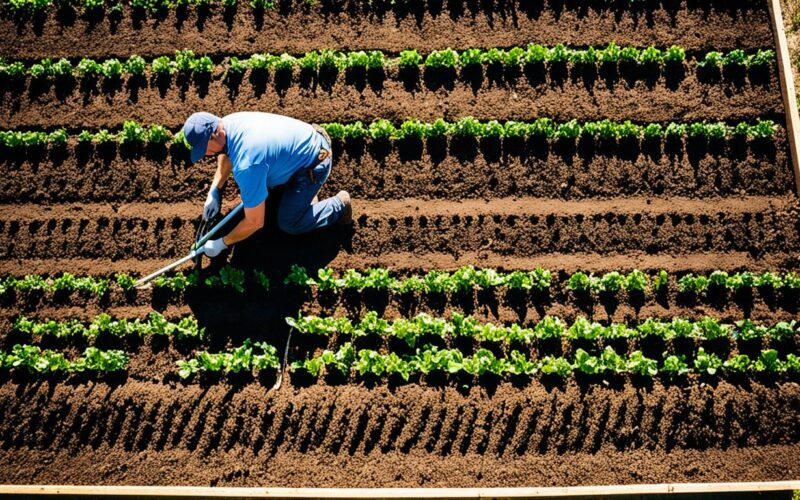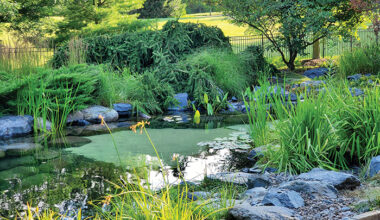Ever thought why your vegetable garden doesn’t look as neat or productive as you’d like? The secret might be in how you prepare your garden rows. Learning hoe gardening can turn your garden from messy to organized, which can also increase your harvest. Let’s explore how to make garden rows with a hoe perfectly.
Garden row preparation is more than just making your garden look good. It’s about creating a space where your plants can grow well. With the right method, you can boost your crop harvest. That means more tomatoes, peppers, or carrots for you to enjoy.
Are you ready to improve your gardening skills? Whether your garden is small or large, the basics of creating perfect vegetable garden rows are the same. Keep reading to learn about the tools, techniques, and tips to make you a pro at garden row preparation.
Overview of the Importance of Garden Rows
Garden rows are key to a successful backyard vegetable garden. Using the right hoeing techniques can greatly help your garden. Let’s see why straight rows are vital for your garden.
Benefits of Well-Organized Garden Rows
Straight furrows have many benefits for your plants. They help with spacing, letting roots get nutrients and water better. A study by the University of Minnesota Extension showed that rows made with a hoe can boost crop production by up to 25%.
Impact on Plant Growth and Yield
Well-planned rows give plants the right amount of sunlight and water drainage. Most plants need at least 6 hours of sunlight a day. Proper spacing in rows means each plant gets enough light, leading to healthier growth and more produce.
Ease of Maintenance and Harvesting
Straight rows make garden tasks easier. They make weeding, watering, and picking produce simpler. Tools like a wheel hoe work better in well-organized rows. Rows are usually 10 to 20 feet apart, giving space for different crops and easy access.
By using these hoeing techniques, you’ll have a neat, productive garden. Remember, a successful garden comes from careful planning and making the right rows.
How to Make Garden Rows with a Hoe
Creating garden rows with a hoe is key for gardening success. It helps plants grow well and makes upkeep easier. Let’s explore how to make straight garden furrows.
Selecting the Right Hoe for Garden Row Creation
Finding the perfect hoe for your vegetable garden rows is crucial. The size of your garden, the type of soil, and your comfort matter a lot. For big gardens or hard soil, a heavy-duty hoe is best. Long-handled hoes offer better control and protect your back during long use.
Draw hoes, like the True Temper or Leonard Garden hoe, are perfect for making furrows. They can make planting faster than random planting. For weeding between rows, a scuffle hoe, such as the Diamond hoe or Winged weeder, cuts weeding time in half.
Multi-purpose hoes, like the A.M. Leonard Versahoe, are versatile for different gardening tasks. For creating precise rows, use a Warren hoe. It helps keep rows 18 inches apart, which can increase plant yield by up to 20%. Short-handled hoes are ideal for small gardens or raised beds.
The right hoe makes your vegetable garden rows neat and productive. It’s important to find the perfect fit for your garden needs.
Preparing Your Garden Space for Row Making
Clearing the area: Begin by removing all debris, weeds, and rocks from your garden. A clean area makes soil work easier. Use a rake for loose materials and a hoe for tough weeds. A weed-free garden helps your plants grow better.
Soil preparation techniques: Healthy soil is crucial for a great garden. Break up big clumps and remove rocks. Here are some tips for better soil:
- Test your soil pH and adjust if needed
- Add organic matter like compost
- Till the soil 8-12 inches deep
- Level the surface with a rake
Marking row locations: Plan your garden layout next. Use stakes and string for straight rows. Rows should be 18-36 inches apart, based on your plants. This makes maintenance and harvesting easy. For raised beds, make soil mounds along these lines.
These steps help create a perfect spot for your plants. Proper preparation leads to a great harvest all season.
Proper Hoe Technique
Begin by holding the hoe handle with both hands. Stand with your feet apart and face the row at a 45-degree angle. Push the hoe into the soil and pull it towards you, making a furrow.

Creating Consistent Furrow Depth
It’s important to keep furrows the same depth for even plant growth. For most veggies, aim for depths of 1-2 inches. Adjust as needed for different plants.
Potatoes, for example, need deeper furrows, about 5 feet apart for planters and diggers.
Maintaining Straight Lines
Having straight furrows makes gardening easier. Use stakes and string as guides. Stick stakes at each row end and a string between them. Hoe along this line, checking often to stay on track.
Remember, different plants need different row spaces. Tomatoes are usually 6 feet apart with 30 inches between each plant. Beans prefer 30-inch rows. Adjust your hoeing for your plants’ needs for the best results.
Spacing and Layout Considerations for Garden Rows
When planning your backyard vegetable garden rows, getting the spacing and layout right is crucial. The traditional row layout is still a favorite among gardeners. It’s vital to think about what each plant needs when figuring out how wide and close together they should be.
For garden row preparation, keep these guidelines in mind:
- Tomatoes: 24-36 inches between plants
- Carrots: 2-4 inches between plants
- Lettuce: 6-8 inches between plants
A good rule for vegetable garden rows is to keep about 18 inches between each row. Also, leave 22 to 24 inches for walking paths. This way, your garden uses space well, plants don’t fight for resources, and they stay healthy.
Think about using raised row beds for your garden. A 10′ x 15′ area is perfect for this. You’ll need about 6 to 8 inches of soil over a 3 to 5-inch straw layer. This method can bring in up to 5 tons of veggies over two seasons.
Smart spacing in your garden rows boosts your yield and makes maintenance and harvesting easier. With some planning, even a simple row layout can be both useful and look great.
Enhancing Soil Health in Your Garden Rows
Garden soil cultivation is crucial for a thriving vegetable patch. Healthy soil supports strong roots, better nutrient uptake, and resilient plants. Let’s look at ways to make your soil more vibrant for a great harvest.
Adding Organic Matter
Adding organic matter boosts soil structure and nutrient levels. Spread 2-3 inches of compost on your rows before planting. If your soil is really poor, add 3-4 inches. This is great for raised beds with hoes.
Incorporating Compost
Compost enriches soil biology and fertility. Mix it into your soil when preparing your garden rows. Add ½-1 inch of compost each year for ongoing care. This keeps your soil and plants healthy.

Mulching Techniques
Mulching helps with moisture, weed control, and temperature. Put a 2–3-inch layer of organic mulch around your plants once they’re established. It’s good for both traditional and raised beds.
Keep your soil’s pH between 6.0-7.0, with 6.5 best for most veggies. Test your soil regularly and adjust as needed. This keeps your garden rows productive year after year.
Maintaining and Caring for Your Garden Rows
Mastering garden hoeing is just the start. Keeping your vegetable garden rows in top shape is key for healthy growth and lots of produce. Start by weeding often, as many gardeners use a hoe for this. Weeds can steal nutrients and water from your crops.
Watering is crucial for hoe gardening. Check the soil often and water when needed. About 13% of gardeners use the 2×4 method to make shallow furrows. This helps water spread out evenly and can save time.
To boost your garden, add compost or organic fertilizers as you go. Nearly half of gardeners make their own tools for this. Mulching around plants keeps the soil moist and stops weeds. Also, switch up where you plant each year to keep the soil healthy and stop pests from building up.
To Conclude
This guide has transformed the humble hoe from a simple tool into a powerful weapon in your vegetable gardening journey. You’ve learned how creating well-defined rows with a hoe isn’t just about aesthetics; it’s a strategic approach to maximizing your harvest and simplifying garden maintenance.
Straight rows promote optimal plant growth by ensuring proper spacing for sunlight, water, and nutrient access. Choosing the right hoe for your garden size, soil type, and comfort is essential. Different hoes excel at specific tasks, like furrow creation (draw hoe) or weeding (scuffle hoe).
Proper soil preparation is crucial. Marking your rows with stakes and string ensures straight furrows and simplifies planting. Consider exploring raised bed gardening. This method offers several benefits, and raised rows can still be easily created using your newfound hoeing skills.


